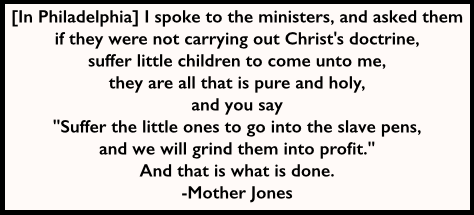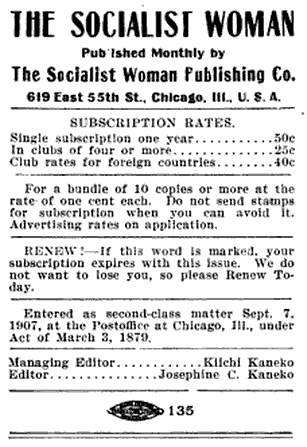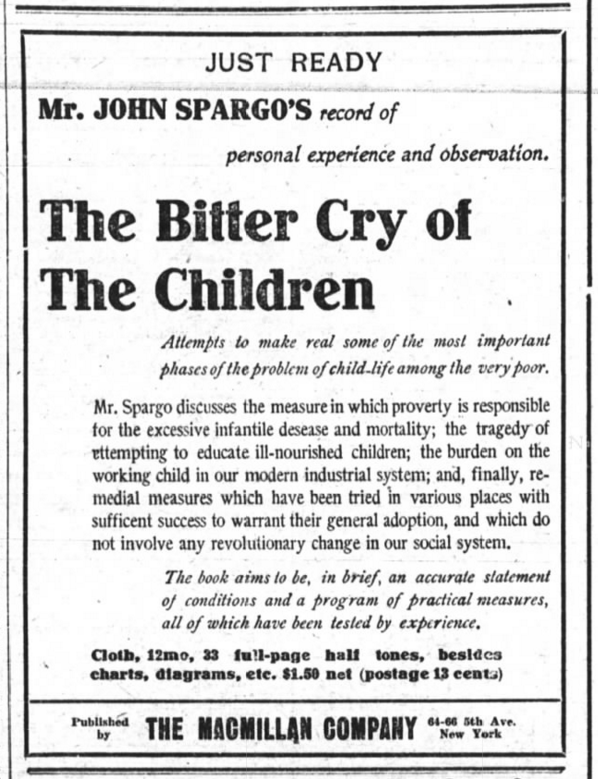
Hellraisers Journal, Thursday March 5, 1908
Josephine Conger-Kaneko on Crime of Child Labor in America
From The Socialist Woman of March 1908:
THE HORRIBLE CRIME OF CHILD LABOR IN AMERICA.
—–
Josephine Conger-Kaneko.“How long,” they say, “how long, Oh, cruel nation
Will you stand, to move the world on a child’s heart;
Stifle down with a mailed heel its palpitation,
And tread onward to your throne amid the mart?”
A little over one hundred years ago the first act was passed by the British Parliament to abate the evils of child labor.
The workhouses of London at that time were crowded with pauper children to the extent that their managers were paying a premium to the manufacturers to take them off their hands. These puny, half-starved children whom nobody owned, orphans, deserted infants, who had become a burden on the tax payers, were sent by the hundreds and thousands to supply the demand for cheap labor which was springing up in factories on every hand. They were housed in barracks, were driven long hours at hand tasks by their overseers, were fed the coarsest of food, and died by scores from disease—bone rot, curvature of the spine, consumption, and other infections produced by their manner of living.
It was this state of things that brought about the first law regulating in any way the labor of the child. This law was passed in 1802. And it was but the merest beginning. The evils of child labor were so many, so varied and so persistent, that to this day there is no adequate child labor law in the whole world. In 1833 it was estimated that in England there were 56,000 children between nine and thirteen in factories. many of whom worked sixteen hours a day. The English Woman’s Journal of 1859 gives the following account of pauper children in London:
The boys and girls from the Metropolitan Workhouse are sent to a large “farm” school a few miles from town. Many hundreds of children are there, from various unions. They are placed out at so much a head, fed by contract and taught by contract, the “so much” being so little that the contracting parties do not hold themselves bound to attend to their welfare, as they would that of animals placed on like condition under their care. Either from low living or bad ventilation, diseases of many kinds are prevalent among them. The girls at twelve years old are sent back to the “houses,” perhaps the only home they ever knew. The “house” cannot keep them; the rates must be kept down; the vestrymen must not become unpopular by expensive arrangements. The children must go somewhere.
They have learned a little reading, very little writing, perhaps part of the multiplication table, a few questions from the Bible, and probably the catechism. They have gained no experience of the work that will be expected from them, still less have they been practiced in the self-control that might enable them to bear unreasonable demands on their helplessness and ignorance. They are “placed out” as servants, with small trades people, laundresses and others of the same class; the drudgery required of them is far beyond their strength and ability. They, that is a very large proportion of them, run away, but they must live, and how do they live? Go into the low streets, alleys and gin shops, in an evening, and you will find them, destroying and destroyed. Go, a few months later into the Magdalen ward of the workhouse, their first home, and there you find these almost children. Some, and those the happiest of all, have gone where more mercy will be shown their youth and friendlessness; others, wasted by disease, await their release; and some, whose lot is worst of all, alternate between suffering and vice, the sick ward and the street.
Such was the condition of affairs under the early child labor laws of England. In the United States and in the twentieth century we do not, of course. expect to find so neglectful a disposition toward our young, and we have, as proof of our higher altruism, numerous and intricate laws for the protection of children against the greed of unscrupulous employers. Upon these laws we pin our faith, and when the question of child labor comes up, we point to these objects of our endeavor, and even add that we are willing to have more laws passed until the children of the working class are hedged about with every possible protection against the octopus of greed.
Many of us do not see that there is a leakage in the laws. That our good intentions miscarry to a criminal extent and that we might even compare our conditions with those of earlier English days, without a very serious detriment to the latter. A member of the National Child Labor Committee says in this connection that
The lack of adequate statistical inquiries makes it impossible to express in figures the extent of the evil of child labor. But wherever investigation is undertaken, wherever the surface is even scratched, we are shocked to find to what an extent the disease is eating away underneath, even in those states in which legislation on the subject is almost ideal. The laws are admirable, but the enforcement is defective.
In 1903 there were 20,000 children under twelve years of age in the cotton mills of the South. These 20,000 children represent the purest of American blood. They are not the offspring of negroes, nor of foreigners whose one desire is to get a foothold in this new land, no matter what the immediate cost. The illiteracy of the Southern white is largely due to this feeding of the child into the mill, while it is still in its years of infancy. Fourteen years is a very early age at which to stop all educational processes and begin life as a wage earner. Yet there are 60,000 mill operatives under fourteen years of age in the South. And with the development of the cotton industry the evil will not diminish but will grow.
Rhode Island, with a twelve year labor limit up to 1907, left even this limit unenforced, and has become the most illiterate of the Northern states. Indeed, New England with its millions of spindles does not hold itself above the infringement of the child labor laws, nor can it, under the present industrial system. This fact is so recognized that the spinning frame is built for a child of from twelve to fourteen years of age; it is hard for an adult worker to do that particular work through having to stoop to the task. It is said that spinning frames made for East Indian trade show a marked difference in the matter of height, the East Indian having not as yet developed to the point of exploiting child labor.
Other industries of the East and North are as sadly destructive to the welfare of the child as are the cotton mills of the East and South. One line of child labor which has received less attention than have many of the others, is especially pernicious in its destruction of the youths engaged in it. This may be called the street trades, with the news boy in the lead. The very freedom and openness of the newsboy’s life seems to hold him immune from the investigations and restrictions even of an inadequate law.
Many of us have seen boys of seven, ten and fourteen sleeping in hallways, and on the open grating of a sidewalk, on frosty nights. We have pitied such a boy, but our pity has been offset by a recognition of his hardihood, of his remarkable endurance. It seldom occurs to us that he may be suffering from disease; that his mind and soul may be black with the filth of the street; that he is human and imbibes that which is most prevalent in his environment. The newsboy, as well as the messenger boy, on account of his availability, frequently is found in the “red light” district, and as a messenger boy for men and women of dissolute character, learns the worst side of a city’s life. Mr. Sloan. the superintendent of the John Worthy School of Chicago, authorizes the statement that:
One-third of the newsboys who come to the John Worthy School have venereal disease, and that 10 per cent of the remaining newsboys at present in the bridewell, are, according to the physician’s diagnosis, suffering from similar diseases.
I have seen little girls not over eleven years of age standing on the street corners of Chicago in cold winter weather, crying their papers with a voice so hoarse as to suggest a lung affection. Small boys of eight and even younger, hop on and off the moving street cars with their papers, all over the city.
With the fierce competition between the newsdealers of today, the few pennies the small newsboy can pick up cannot in any degree compensate him for the evils he encounters, and the manner of life he imbibes from his street trade. Too many of his kind fall beyond recovery, and their blight does not stay with themselves, but becomes merely a link in a chain of evils which projects itself for an indefinite length into the future, contaminating that part of the social organism with which it comes in contact.
According to the Twelfth Census Report, children from ten to fifteen years engaged in large numbers in gainful pursuits are as follows: Agricultural laborers, 1,054,700; domestic and personal service, 280,143; servants and waiters, 138,284; trade and transportation, 122,507; messenger and errand boys, 42,046; woodworkers, 11,000: miners and quarrymen, 24,217; tobacco and cigar factory operatives, 11,462.
Altogether, something like two million children are working for wages in this country. And each decade sees an immense increase in their numbers, in spite of legislation to the contrary. Furthermore, there can be no hope for American childhood of the working class so long as we insist upon a purely material prosperity, so long as industry is carried on for profits, so long, in fact, as we persist in placing property rights above human rights. So long as we build our social order upon these ideals, we are merely scratching the surface of things when we legislate against child labor, which is but one of the fruits of the present system.
———-
FROM THE AUTHOR OF “THE BITTER CRY OF THE CHILDREN.”
—–My Dear Comrade Kaneko—I have wanted to write you for such a long time past to say how much prosperity I wish you and how profoundly I sympathize with what you are doing to reach the women. Now, at half-past eleven at night, having just laid aside my work, I take the few minutes before “turning in” to gratify my desire. I really am ashamed not to have written the article you asked me for, but really I have been overwhelmed with work. You must pardon me, therefore, and accept a promise for the present. I really will send you an article as soon as I can. I have your claims ever in mind. As you know, I have been of the opinion that special attention ought to be given to propaganda among women for a long time past. I remember with pleasure our correspondence when you were on “The Appeal [Appeal to Reason].” Along the same lines I have sent Kerr an article for the International [Socialist] Review on the need of agitation among women, and a fuller recognition of women in the party life. I think you will agree with most of it. I enclose a dollar for four subscription cards. I hope things are going well with you and that you keep as enthusiastic as ever. The out look for Socialism is better than ever it was, and I am looking forward to a big vote. It is my personal opinion that we ought to have a national woman’s committee in connection with the party to carry on work among women. Keep plugging, good comrade, and never give up. Cordialily, John Spargo, Yonkers, N. Y.
[Photographs added.]
SOURCE
The Socialist Woman
[Later-The Coming Nation]
-March-Dec 1908
https://books.google.com/books?id=OvM4AQAAMAAJ
The Socialist Woman
(Chicago, Illinois)
-March 1908
https://play.google.com/books/reader?id=OvM4AQAAMAAJ&printsec=frontcover&output=reader&hl=en&pg=GBS.PA1
“The Horrible Crime of Child Labor in America”
-by Josephine Conger-Kaneko
https://play.google.com/books/reader?id=OvM4AQAAMAAJ&printsec=frontcover&output=reader&hl=en&pg=GBS.PA8
Note:
Sadly, while solidarity of all the workers was preached, casual racism is, nevertheless, often found in the early Socialist movement:
In 1903 there were 20,000 children under twelve years of age in the cotton mills of the South. These 20,000 children represent the purest of American blood.They are not the offspring of negroes, nor of foreigners whose one desire is to get a foothold in this new land, no matter what the immediate cost. The illiteracy of the Southern white is largely due to this feeding of the child into the mill, while it is still in its years of infancy.
IMAGES
Socialist Woman, eds Kaneko and Josephine Conger, March 1908
https://play.google.com/books/reader?id=OvM4AQAAMAAJ&printsec=frontcover&output=reader&hl=en&pg=GBS.PA6
Ad: Bitter Cry of Children, Spargo, NYT, Feb 17, 1906
https://www.newspapers.com/image/20459100/
See also:
National Child Labor Committee
https://en.wikipedia.org/wiki/National_Child_Labor_Committee
http://58798683.weebly.com/
The Bitter Cry of the Children
-by John Spargo
NY, 1906
https://archive.org/stream/bittercrychildr02spargoog#page/n8/mode/2up
https://books.google.com/books?id=jRtShCzm4ygC


